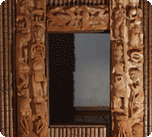 |
 |
 |
| The Baham museum |
 |
 |
 |
 |
| Permanent exhibition |
 Country and history Country and history |
 Secret societies and religion Secret societies and religion |
 Costumes and textile art Costumes and textile art |
 Musical instruments Musical instruments |
 Receptacles and other containers Receptacles and other containers |
 Kings and dignitaries Kings and dignitaries |
 The artists The artists |
 The figures of justice The figures of justice |
 Maternity, fertility and war Maternity, fertility and war |
 Architecture Architecture |
 Itineraries of the collective memory Itineraries of the collective memory |
 |
 |
 |
| Information |
 |
 |
|
Country and history
| The kingdom of Baham has between 35,000 and 60,000 inhabitants (including the diaspora) for an area of about 72 km². It is part of the hundred or so gung (chefferies or kingdoms) which were progressively formed in Bamiléké country over the past six centuries. The territory of Baham appears as a succession of low hills, at times rocky, on top of a high plateau almost 1600 m above sea level on average. The highlands with a lateritic soil are covered with poor grazing land and fairly poor crops, whilst the valleys with fertile soil are rich farming land. |
|
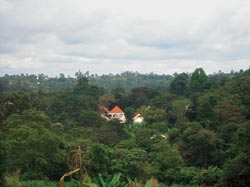 |
| |
|
 The museum of Baham in the landscape. The museum of Baham in the landscape. |
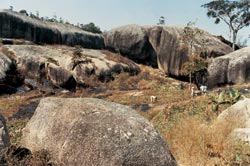
 Fovu Fovu |
|
The tropical mountain climate has two seasons: the dry season from November to mid-March, whilst the rainy season covers the rest of the year. Forest-tunnels, waterfalls, rocks and streams, presenting an unusual aspect in places, are places of worship and the setting of disturbing legends. Ghomala’, is spoken in Baham and is one of the languages related to central Bamiléké central, a sub-group of the Bantu languages of the Grassfield. These contemporary languages are only the result of a long diversification resulting over thousands of years in a single basic language at least 5000 years old and which was born in the Grassland. |
The kingdom of Baham is a small nation-state ruled over by a figure considered as sacred, the fo or feu (chief, king). The capital tsa where the king resides in the main cultural, administrative and religious centre. A place of assimilation, by the strictness of its organisation, subtle balance of powers and counter-powers but above all dialectic relations between individuals and the community, the kingdom or chefferie in the Grassland, like Baham, astonishingly resists time by allying tradition and modernity. |
|
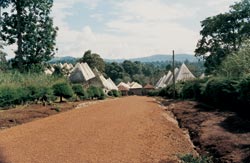 |
| |
|
 The entrance to the royal residence, tsa The entrance to the royal residence, tsa |
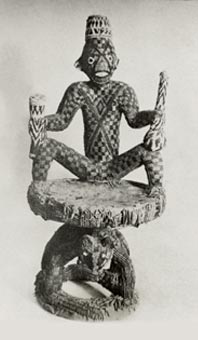 |
|
The emergence of the kingdom of Baham is highlighted by historical facts, but these are also more often than not surrounded by myths, legends, ideological and even contradictory considerations according to the sources. According to one of the versions, hunters originally from the kingdom of Bangam (at the time located on the present Bamoum plateau around Kougham) crossed the Noun at the level of Bamendjing and came to settle further away in the sector where the present Baham royal residence is, where they lives ad chiefs of independent groups. By cunning and by force, one of them or of their descendants (Bussu or Kameugne) succeeded in imposing himself as king amongst his fellows and the pre-established petty kings and truly founded Baham in the 16 th or 17 th century.
The term Baham itself is a deformation of « Pa Hom» coming from the expression « Pa Hom meu dye » which literally means “the people who shut up a man in a hut without a door”. According to the legend, this event is believed to have taken place for the conquest of power under the late Bussu (the man shut up was a rival according to the first version) or under another chief, threatened by his own children and their accomplices (2nd version). In any case, the abbreviated expression « Pa Hom» was to designate after that the group of assailants and later the inhabitants of the sector and their territory. |
 Beaded throne of King Kamdem I Beaded throne of King Kamdem I |
|
|
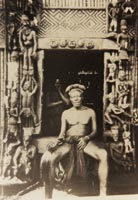 |
|
The history of Baham since its foundation until the start of the 20 th century is marked by the changes of the royal residence, the expansion of the territory through conquests, the submission of several populations beaten by the warrior kings, the most famous of whom was Kamdem I who was also a great builder. In June 1905, Captain Glauning explored the centre and south of the Bamiléké plateau the submission of which to the German imperial authority was more theoretical than real. Besides, he was prohibited from entering the territory of Baham by King Kamdem II. It was war. Despite a heroic resistance, the kingdom of Baham was defeated and lost more than one hundred men. The royal residence was burnt. Several objects of art and royal emblems were stolen, collected, pillages, confiscated or given as a tribute and they went to Germany. In 1928, King Pouokam I Guiakam, the successor of Kamdem II, led a warring expedition against Bayangam, following an old dispute over land. The affair was brought before the court of Dschang which sentenced Pouokam I to three years’ imprisonment and 20 years of banishment.
|
 Roi Pouokam I Roi Pouokam I |
|
|
| |
|
|
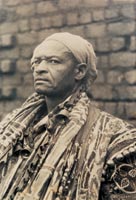 |
|
His son Kamwa ensured the interim until 1935, the year in which he succeeded his late father. This passsing of power was not appreciated by all the Baham which led to some dissent.
In the 1950s and 60s, a bloody war of liberation led by the nationalists of the UPC (Union of the Populations of Cameroon) against the French coloniser for total independence of Cameroon was overtaken in Baham by the crisis of the succession of King Kamwa who died in 1954: the supporters of Prince Kamdem Ninyim Méku and those of Prince Teguia Demgne fought tooth and nail, each side believing its fight legitimate and right. |
 Roi Kamwa Roi Kamwa |
|
|
| |
|
|
 |
|
Despite the protests of the Baham, the colonial administration interfered in the choice and craftily supported first one and then the other, according to the opportunities and interests. In 1954, Kamdem Ninyim initiated and enthroned, acceded to power.
But he was soon on bad terms with the notables and with the administration that had supported him. He was replaced in 1956 by Téguia who became the new king of Baham. |
|
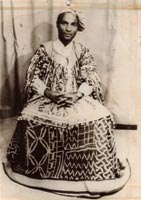 |
 Roi Ninyim Roi Ninyim |
|
|
|
 Roi Teguia Roi Teguia |
| |
|
|
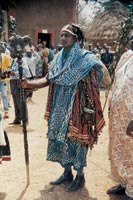 |
|
Despite the return to power of feu Ninyim for a few years (before unfortunately being shot in 1964 after some disputes with the post-colonial government of which he was a member), feu Téguia imposed himself on Baham until 1986. During these troubles, several important elements of the cultural heritage of Baham were destroyed, pillaged and taken away.
In 1986, on the death of King Téguia, his son Pouokam Max II took power. |
 Roi Pouakam Max II Roi Pouakam Max II |
|
|
[ Top page] |



































